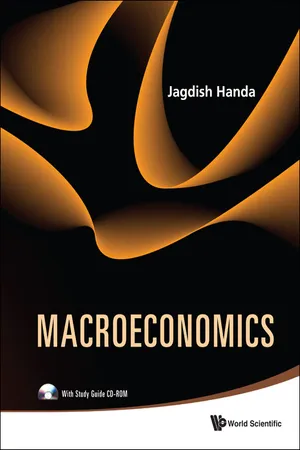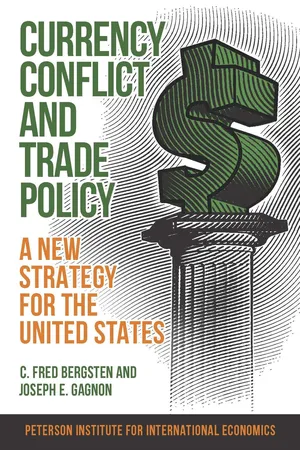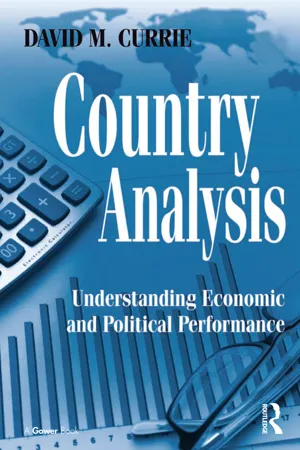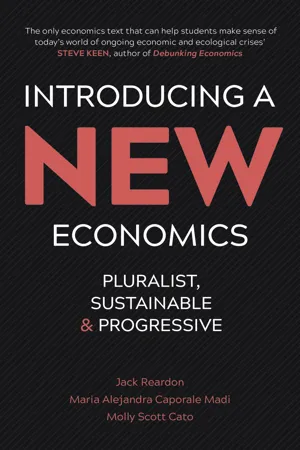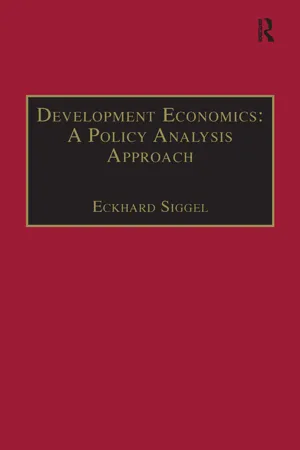Economics
Exchange Rate and Net Exports
Exchange rate refers to the value of one currency in terms of another. Changes in exchange rates can impact a country's net exports, which is the difference between the value of a country's exports and imports. A depreciation of a country's currency can make its exports cheaper for foreign buyers, potentially increasing net exports, while an appreciation can have the opposite effect.
Written by Perlego with AI-assistance
Related key terms
8 Key excerpts on "Exchange Rate and Net Exports"
- eBook - ePub
Macroeconomics
(With Study Guide CD-ROM)
- Jagdish Handa(Author)
- 2010(Publication Date)
- WSPC(Publisher)
Since the exchange markets for financially developed economies tend to be efficient (i.e., go to equilibrium rapidly), the market exchange rate for our economies would tend to be the equilibrium one. However, if the exchange rate has been fixed by the government or the central bank, it might be at the equilibrium level, or above or below the equilibrium level. If it was set above the equilibrium level, the economy would have a balance of payments deficit; if it was set below the equilibrium level, the economy would have a balance of payments surplus.Since both commodity and capital flows are components of the demand and supply of foreign exchange, changes in the net exports of commodities and net capital flows both produce changes in the market exchange rate. In the short term, capital flows are usually more volatile, so that short-term fluctuations in the exchange rate are usually due more to fluctuations in capital flows than in commodity flows.Chapter 12 will further expand on this analysis of the foreign exchange market.Figure 3.1Fact Sheet 3.4 : Exchange Rates against the US Dollar, 1980−20083.9.1 Hot moneyThis Fact Sheet illustrates movements in the exchange rates in terms of the US dollar of the currencies of several countries. Some of these countries had pegged exchange rates for part of the selected period. For example, the decision to peg the national currency to the US dollar was taken by Argentina from 1980 to 1988 and from 1991 to 2001, by Mexico in the early 1990s, by Malaysia after 1997, and by China in 1993. When this peg became unsustainable, they switched to a floating exchange rate. The depreciation experienced after such a switch is evident for Argentina in 1988 and 2001 as well as for Mexico in 1991.Some of the capital flows among countries are extremely sensitive to expected interest and exchange rate changes, as well as to the political and economic insecurity in the country. Speculation about a possible devaluation/depreciation of the domestic currency can cause sudden, heavy outflows of short-term funds seeking protection from it, or trying to make a profit out of it. Funds whose flows among countries are very sensitive to expected exchange rate changes, interest rate fluctuations or security and convertibility (i.e., unhindered exchanges among currencies) considerations are known as hot money. - eBook - ePub
- W. Charles Sawyer, Richard L. Sprinkle(Authors)
- 2020(Publication Date)
- Routledge(Publisher)
CHAPTER 14Exchange rates and their determinationA basic modelThe exchange rate is determined from day to day by supply and demand of home currency in terms of foreign currency. Each transaction is two-sided, and sales are equal to purchases. Any change in the conditions of demand or of supply reflects itself in a change in the exchange rate, and at the ruling rate the balance of payments balances from day to day, or from moment to moment.Joan RobinsonINTRODUCTIONT he international value of a country’s currency has become an inescapable part of the daily flow of economic information. Most of us are aware that a country’s exchange rate is important, but many of us do not have a clear idea of why the exchange rate matters or what causes it to change. As the chapter’s opening quote indicates, the familiar tools of supply and demand analysis can be used to determine a country’s exchange rate. In this chapter, you will learn why the supply and demand model works in analyzing exchange rates—in the same manner, in fact, that it works in analyzing the price of gasoline or pizza, for one dollar or one yen or one gallon of gasoline is indistinguishable from another. By the end of this chapter you should have a good grasp of why exchange rates are important and what factors cause them to change over the long run. Finally, it is obvious to even a casual observer that exchange rates change frequently. These changes, or volatility, are a source of aggravation for individuals, businesses, and governments. The chapter explains what economists know about the effects of exchange rate volatility on international trade and how changes in exchange rates affect the prices of the goods and services we purchase. The final part of the chapter deals with the underlying value of a currency. While the exchange rate we observe in the market often differs from that value, it is very useful to know what that value is.EXCHANGE RATESSuppose that a U.S. importer is purchasing British Jaguars. To purchase the Jaguars, the importer needs to obtain British pounds by exchanging dollars for pounds. The demand for foreign currency is derived from individuals demanding foreign goods and services. This relationship can be applied in reverse. As individuals in the U.K. demand U.S. products, there is an increased demand for dollars. However, this raises the question of how many dollars must be exchanged to obtain the requisite number of pounds, or vice versa? In this example, the relevant exchange rate is the U.S. dollar–U.K. pound exchange rate. In general, the exchange rate is the price of one country’s currency in terms of another. The demand for British pounds relative to the supply of pounds will determine the exchange rate, just as the demand for gasoline relative to the supply of gasoline determines the price of gasoline. Exchange rates fluctuate considerably over time. However, unlike the price of gasoline, changes in the exchange rate are expressed as changes in the value of the domestic country’s currency. An increase in the value of a currency is referred to as appreciation. Analogously, a decline in the value of the currency is referred to as depreciation - eBook - ePub
Currency Conflict and Trade Policy
A New Strategy for the United States
- C. Fred Bergsten, Joseph Gagnon(Authors)
- 2017(Publication Date)
2 Key Conceptual Issues This chapter describes the forces that move the trade balance in the short run and the long run. At the broadest level, a country’s trade balance reflects the difference between saving and investment within its borders. 1 Countries with excess saving have trade surpluses; countries with excess investment (in housing, factories, and infrastructure) have trade deficits. Macroeconomic and financial policies, including exchange rate policy, have important effects on saving and investment and thus on the overall trade balance. Currency intervention was an important—probably the most important—driver of the record global trade imbalances in the first decade of the 21st century. Other important fundamental influences included business cycles, fiscal policy, demographics, and trend growth rates. In addition, excesses in private financial flows that are not well explained by fundamental influences have often led to large swings in exchange rates and unsustainable imbalances in trade. Because one country’s trade surplus must be associated with trade deficits elsewhere, one country’s policies or financial excesses have important effects on other countries. The Trade Balance and the Current Account Balance In this book we use the terms trade balance and current account balance almost interchangeably. For most countries, including the United States, the two concepts amount to almost the same thing. The trade balance is defined as exports of goods and services minus imports of goods and services. 2 Economic growth is typically measured as growth in the production of goods and services, also known as gross domestic product (GDP). In the economic accounts, GDP is measured as total domestic spending plus exports minus imports. Imports subtract from GDP because they are produced outside a country’s borders; an increase in “net exports of goods and services” adds to GDP growth and a decline in them reduces GDP growth. GDP, in turn, is a key driver of employment - eBook - ePub
Country Analysis
Understanding Economic and Political Performance
- David M. Currie(Author)
- 2016(Publication Date)
- Routledge(Publisher)
explain the factors that influence the value of a currency; 6. explain the difference between fixed and floating exchange rate regimes; 7. explain the risk in a currency transaction caused by appreciation or depreciation of either currency. What is an Exchange Rate? An exchange rate is simply a price that tells you how much a currency is worth in terms of another currency. Because this book is intended for a US audience, most of the discussion will be in terms of how much a US dollar is worth, but the same reasoning applies to any other currency: how much a UK pound is worth in terms of euros, or how much a euro is worth in terms of Japanese yen. Any currency can be stated relative to another currency, and the price is its exchange rate. The exchange rate can be established in two ways: by the government of a country, or by the international currency market. In the old days, before the Second World War, governments set exchange rates that initially were based on the gold content of each country’s coins. When that system ran into complications, rates were set by agreements between governments in what was known as the Bretton Woods system. When the Bretton Woods system failed in the 1970s, most governments left it to markets to determine exchange rates. With a few notable exceptions, today most exchange rates are determined on the currency market. When a government sets an exchange rate and attempts to maintain that value, it is called a fixed exchange rate regime. When governments give up the effort and allow markets to determine exchange rates, it is called a floating exchange rate regime. Between the two extremes are several variations, but those are the choices facing any government: the government can attempt to dictate the exchange rate, or it can leave the decision up to the market - eBook - ePub
Introducing a New Economics
Pluralist, Sustainable and Progressive
- Jack Reardon, Maria Alejandra Caporale Madi, Molly Scott Cato(Authors)
- 2017(Publication Date)
- Pluto Press(Publisher)
With a cheaper exchange rate of the British pound in terms of dollars, won’t this bode well for British manufacturing? The reason for the precipitous decline of the pound in July 2016 was Britain’s vote in the referendum to leave the EU (23 June 2016). Investors feared that without close ties to the EU, global industry, especially financial services, will leave the UK and migrate elsewhere. On the other hand, some analysts argue that the sharp decrease in the value of the British pound will provide the momentum for an export-led recovery. But this provokes the question: With a manufacturing sector of only 10 per cent of GDP (it was 20 per cent in 1995), how can exports lead an expansion (Duke 2016)?There are two types of exchange rates:• Fixed exchange rate: A country’s exchange rate is fixed (pegged) in relation to another nation’s currency, or to some asset, such as gold.• Floating exchange rate: A country’s exchange rate depends on the market forces of supply and demand.To understand the difference, let’s return to our land example. To fix a price for a piece of land means that that price is fixed regardless of market demand . So even if very few people want the land (or even if everyone does), the price does not fluctuate. But if the price of land is determined by market forces, then it will fluctuate depending on how many people want it, i.e. as demand and supply change. To return to the exchange rate, if, all else being equal, demand for US dollars increases relative to the British pound, and supply of dollars remains the same, then the price of the dollar relative to the pound increases.But there is one important difference. If the price of land is artificially held high, for example (by the owners’ decree), then this simply means that the owner foregoes a sale. But holding a currency artificially high (or low) means that the central bank must intervene, by buying (or selling) units of the currency while selling (or buying) another asset in order to obtain the necessary funds. Thus an opportunity cost exists for fixing an exchange rate; and such behaviour cannot continue indefinitely. - Eckhard Siggel(Author)
- 2016(Publication Date)
- Routledge(Publisher)
A situation of external deficit and massive unemployment shown in the diagram by the point A requires a combination of currency devaluation and greater fiscal ease rather than a single policy change, in order to achieve simultaneously external and internal balance. More generally, most situations of disequilibrium require more than one policy measure in order to achieve more than one policy goal. A combination of expenditure-changing (fiscal ease) and expenditure-switching (currency de-or revaluation) is needed to achieve internal and external balance. The Swan diagram also invites a discussion of the assignment problem, that is, which authority is responsible for which policy target, as well as the timing of policy interventions. Since the central bank deals with the exchange rate it naturally bears the responsibility for the external balance target, and the finance minister for internal balance. Exchange rate interventions have a much shorter, even immediate, implementation lag than fiscal policy changes. They may over-shoot the target, however, and need to be coordinated with changes in fiscal ease.Often governments try to avoid devaluation out of fear of increased inflationary pressure and political instability, and then resort to alternative policies, such as import restrictions. In the short run, such policies can help to achieve external balance, but they come at a cost of efficiency losses due to the introduction or increase of price distortions, as we have seen in the previous chapter.6.4 The Real Exchange Rate as a Tool of Analysis
The real exchange rate is an important tool for the analysis of currency misalignment. It has been defined in various ways by different authors. The first, and perhaps most common, definition is that of the nominal rate adjusted for price levels:(6.1) RER = E Pf /Pdwhere E is the nominal rate (i.e. the domestic price of foreign currency), and Pd and Pf are the domestic and foreign price indices, respectively. This definition of the real exchange rate implies that it appreciates4 if domestic prices rise faster than international prices, while the nominal rate remains constant. Alternatively, real appreciation also occurs when the nominal rate declines, relative to the price ratio Pf /Pd . Dornbusch uses the inverse definition (cf. Dornbusch and Kuenzler, 1993), which is also used by the IMF in exchange rate indices:(6.2) RER* = Pd /(E Pf )This inverse of RER has the advantage over the former that it expresses the value of the domestic currency in terms of foreign currency. Therefore, an increase means appreciation and a decrease means depreciation.- eBook - ePub
- Javier A. Reyes, W. Charles Sawyer(Authors)
- 2019(Publication Date)
- Routledge(Publisher)
law of one price : the proposition that identical goods sold in competitive markets should cost the same everywhere when prices are expressed in terms of the same currency.nominal exchange rate : the exchange rate observed in the market.official reserve assets : government holdings of gold or foreign exchange used to acquire foreign assets.real exchange rate : the nominal exchange rate adjusted for changes in both domestic and foreign prices.relative purchasing power parity : the theory that a percentage change in the exchange rate is equal to the difference in the percentage change in price levels.unilateral transfers : grants or gifts extended to or received from other countries.Questions for review and discussion
1 The balance on trade can give one a misleading impression of inflows and outflows into the countries of Latin America. Explain how this can happen.2 For the countries shown in Table 9.2 , explain what must be happening to the financial account.3 Show what would happen to the exchange rate if there was an increase (decrease) in the demand or supply of foreign exchange.4 Suppose there is high inflation in an RCILA. What would happen to the exchange rate?5 If the exchange rate is fixed, then a commodity exporter would need to accumulate foreign exchange when commodity prices are high. Show why this is true.6 If a country has a fixed exchange rate and a current-account deficit, how can intervention be used to maintain the fixed rate?7 Explain how exchange controls can be used to maintain a fixed exchange rate. What country in the region is currently using exchange controls?8 Why would a black market for foreign exchange exist? Which countries in the region now have black markets for foreign exchange?9 Show how capital flight could lead to a rapid depreciation of the exchange rate.10 Describe the term “contagion.” How does it apply to Latin America?11 - eBook - ePub
- Rebecca Driver, Peter J N Sinclair, Christoph Thoenissen(Authors)
- 2013(Publication Date)
- Routledge(Publisher)
10Real exchange rates, current accounts and the net foreign asset position* Christoph Thoenissen1 Introduction
What is the relationship between a country’s current account and its real exchange rate? Is an exchange rate appreciation positively correlated with a current account deficit? Much discussion ofl exchange rate movements in recent years, especially among policy makers and market commentators, has linked exchange rate appreciations with capital inflows or current account deficits.1 The implication is that capital inflows used to finance a country’s current account deficit raise the demand for assets denominated in that country’s currency, causing the domestic currency to appreciate. An example of this kind of reasoning among policy makers is given by the following quote:The bilateral [exchange] rates that are frequently quoted in fact tell us very little about sterling: they are essentially a reflection of the persistent general strength of the dollar on the one hand and the persistent general weakness of the euro on the other, resulting from [emphasis added] sustained capital inflows to the United States in large part from the Eurozone.2This chapter examines the theoretical link between the real exchange rate and the current account using a dynamic two-country stochastic New Open Economy Macroeconomics model. The two key variables of interest in this analysis, the real exchange rate and the current account, are modelled by assuming local currency pricing by firms and the absence of a complete set of state-contingent claims in financial markets, respectively. Modelling both the real exchange rate and the current account in this kind of framework is relatively new. A notable recent example is Bergin (2002), whose focus is however different from ours.When firms are able to set prices in local currency, as opposed to their domestic currency, the law of one price need not hold at all times. This failure of the law of one price leads to deviations from purchasing power parity and drives the dynamics of the real exchange rate in our analysis. Engel (1999) shows that for the United States real exchange rate, deviations from the law of one price of traded goods are the most important source of real exchange rate variability.
Learn about this page
Index pages curate the most relevant extracts from our library of academic textbooks. They’ve been created using an in-house natural language model (NLM), each adding context and meaning to key research topics.
